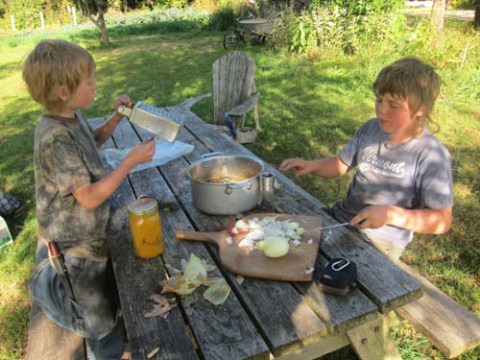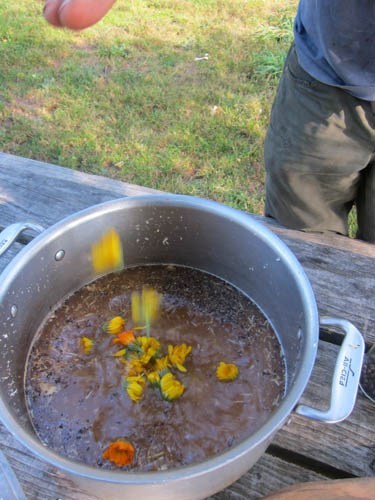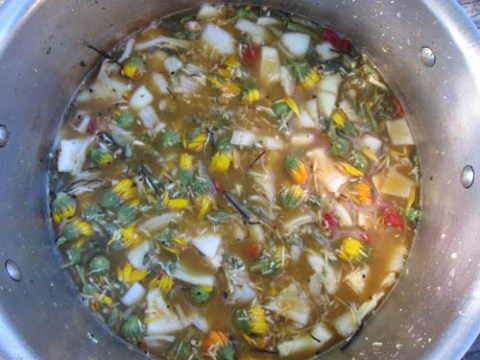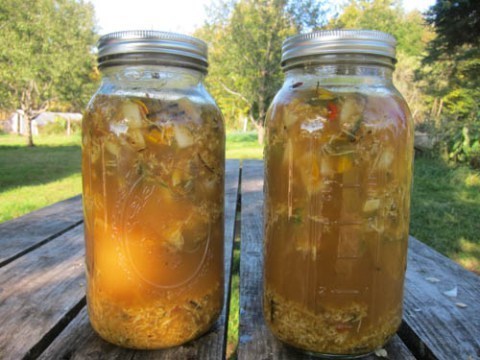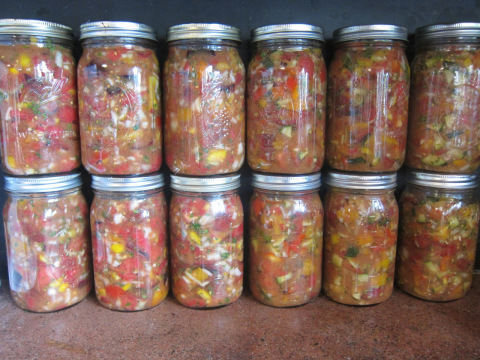Ben Hewitt's Blog, page 43
October 6, 2014
Maybe Not All Things
I’ll be at the Galaxy Bookshop in Hardwick tomorrow night at 7:00 reading from Home Grown and blabbing about all things learning and life. Well, maybe not all things. But you get the idea.

October 1, 2014
Ad Hoc Medicine
A couple of folks asked about fire cider, and since I’m not feeling particularly thoughtful today, I figured I’d satisfy some curiosity.
Fire cider is a traditional folk remedy in use since September 2, 1673. That’s a joke; I have no idea when it was invented, but it’s safe to say it was a heck of a long time ago, though the name “fire cider” has become common only in the past few decades, since the herbalist Rosemary Gladstar coined it in the 70’s. It’s considered an immune-stimulating cold and flu preventative, as well as an aid to digestion and circulation. I’ve read that it makes short people taller, but I’m not entirely sure I believe that one.
There are countless variations, but the main ingredients are fresh horseradish, garlic, onion, hot pepper, and ginger infused in raw apple cider vinegar. Often, raw honey is added. You know, ’cause it’s honey.
We use the above recipe and throw in any other immune boosting and anti-inflammatory/bacterial/viral ingredients we have on hand. For example, we might include Echinacea root, calendula flowers, yarrow leaves and flowers, sage, thyme, rosemary, rosehips, turmeric, and lemon balm. Or we might not; it really depends on what we have in the garden and/or pantry.
As per our usual style, there are no “correct” amounts of these various ingredients. Very roughly, we use equal parts of horseradish, garlic, and onions – maybe two cups each, for those of you desiring precision. We’ll throw in one cup of ginger and handfuls of the remaining goodies. One of the beauties of this concoction is that ginger is the only boughten ingredient; the rest we have on hand,u unless we don’t, in which case we simply vary the recipe to utilize what we’ve got. It’s ad hoc medicine.
So, the process. We grate the horseradish (and be careful, this is some wicked strong stuff, people have actually passed out food processing it, which is why we stick to grating by hand in the great outdoors. Too, we have the boys do it, because of one of them loses consciousness, they have less far to fall) and chop the rest, being darn well sure not to touch our eyes after handling the hot peppers. We throw it all in bowl and cover with the raw apple cider vinegar, stir it around, and ladle into jars. We let it sit for two months before straining.
Fire cider can be taken as a preventative during cold/flu season in 1 – 2 tablespoon doses. If you actually have symptoms, take a shot every 4 hours or so. You can also mix with hot water and honey to make a tea, use it in place of vinegar in salad dressing, or drizzle on cooked veggies and/or rice. Heck, we’ve even added it to marinades and soups.
By-the-by, there’s a brewhaha over the recent trademarking of the name “Fire Cider” by a small Massachusetts company. I don’t know all the details, so I probably ought keep my trap shut, but in general trademarking the name of a common folk remedy sounds like a load of bullocks to me. So there.

September 30, 2014
That Was a Nice Day
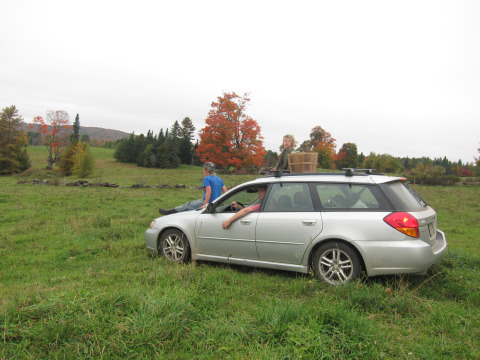
Scouting
We went down to Martin’s place to pick wild apples this morning. Actually, I bet they’re not entirely wild; I bet someone planted those trees, or at least some of them. It would’ve been before I was born. It probably would’ve been before any of you were born, and I know some of you got a few years on me. Maybe even a few decades.
We drove out through Martin’s hayfield and into the back pasture, where his heifers are grazing the last of the sward. The grass has stopped growing; whatever’s on the ground now is all there’ll be until sometime next May. It catches me by surprise every year, just how fast the pasture goes into decline. And now this: Another two weeks of grazing, then seven months of grasslessness. Seven months of throwing bales and busting through iced-over water troughs. I don’t mind. I look forward to it, actually.
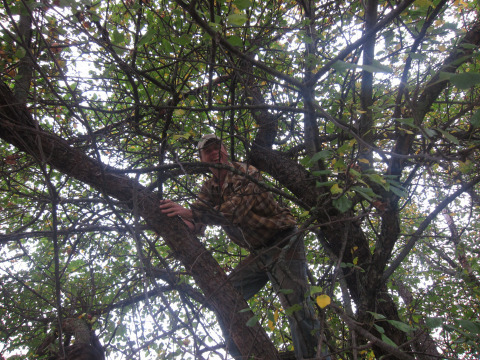
Shaking
The boys weren’t in a great mood this morning and I can’t say why. It happens, I guess. They bickered and wrestled a bit more aggressively than strictly necessary, while Penny and I tried to ignore them. We did a pretty good job of it, too. They didn’t help much but we still let Fin drive back across Martin’s pasture and Rye got behind the wheel for the trip down our quarter-mile driveway, and this seemed to cheer them up considerably.
It’s been an amazing fall thus far. Warm. Dry. The foliage is as fine as I can remember. You stand at the height of our land and you look across the valley and you think it can’t get any better than this. Then one afternoon you’re driving Melvin’s cows down for evening milking and you see his big black and while Holsteins etched against the all that crimson and orange and you realize you were wrong before. Truth is, it can’t get any better than this. Two mornings later, you’re climbing into an old apple tree to shake the fruit down (and sure, the boys are grumpy but screw ‘em) and Martin’s heifers are gathered around, waiting for errant bounces. And then you realize you were wrong that time in Melvin’s field, too, because this is the moment that crystallizes fall. This is the moment you’ll remember in 35 years, when you’re no longer able to climb apple trees to shake the high branches, the ones that stubbornly hold the sweetest fruit. You know what’s funny? I first wrote “truth” instead of “fruit.” I meant to write “fruit” but maybe “truth” works, too.

Snacking
Nah, I’m smarter than that. I bet I won’t remember this morning, climbing that tree, the sour boys, the gathered heifers, the branch-scratch on my forearm oozing beaded blood. Or if I do remember, it’ll be in some hazy, generalized way, how the four of us used to gather apples every fall and I can almost recall that one September morning, the nicest start to autumn we’d had in years and didn’t Fin drive us back through the pasture?
Yes. Yes. That was a nice day.

September 29, 2014
Why My Friend Tried to Stab Me
A friend sent me an email last week to say she’d had a dream in which she and I were eating lunch at a diner and I was blathering on about something in my usual way and she raised her fork at me in a fashion she claims was not menacing and said “No! You listen TO ME!” Because otherwise, she couldn’t get a word in edgewise.
This may mean nothing. On the other hand, I think it’s sort of telling that she didn’t have a dream in which she was trying to get me to speak up.
With that, I present to you my second consecutive nearly-wordless post. Unless you’re one of those deluded sorts who thinks a picture is worth a 1,000 words. I mean, really: 1,000 words? Do you know how friggin’ hard I have to work for 1,000 words?
Eh, never mind. Because now I’m closing in on my fourth paragraph about how maybe I don’t spend enough time with my yap shut.
Damn. I can almost understand why my friend tried to stab me.

Taking the cows down for afternoon milking

Lunch

Caught
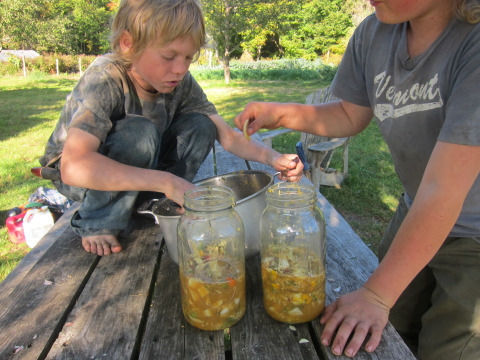
Making fire cider

Surf n’ turf

September 26, 2014
That Time of Year
September 25, 2014
Survive This
I had a really fun and wide-ranging conversation with Jack Spirko of The Survival Podcast yesterday. The episode went up this afternoon. I was a little leery of the “survivalist” angle, based mostly on my own ill-informed preconceptions, but Jack proved to be a great shit shootin’ partner. Go ahead and listen for yerownbadselves.

Merely A Choice
Last night while Penny read to the boys, I cleared a spot in the midst of the kitchen counter chaos (basket of tomatoes, pile of onion peels, jar of sourdough starter, dirtied utensil miscellany, a few things I probably shouldn’t mention, and so on) and churned up a mess of butter. I’ve been on a bit of a butter-making bender; both Apple’s and Pip’s calves are fully weaned, and the volume of milk emerging from our humble little pole barn is awesome to behold. We don’t generally milk two cows concurrently, but this year we’re feeling particularly Taker-ish, and my churning ritual has become a daily affair.
Our butter-making technique is about as low-tech as it gets in this day and age, an almost Luddite-ian process that begins with hand milking and ends with an old hand-crank churn I snagged of Ebay a while back. Prior to the churn, I used our electric food processor and that worked fine, but the noise of the thing set all of us on edge. Truth is, the hand crank model is almost as fast, and other than the fact that I’ve had to cut all my shirts to accommodate my churn-honed right triceps muscle, there’s little downside to it. And what with the bulging triceps, my “I heart Ozzy” tatt is really something to behold, so there’s that.
To separate the cream, we simply filter the milk into large pots and let them sit overnight in the fridge. I skim it once in the morning and then let it sit again until evening, when I snag a second skim. This works because we milk once-per-day; if we milked 2x/daily, there’d simply be too many cream separating vessels to fit in the fridge, though I suppose the basement is cool enough to suffice. But truth is, 1x/day milking works just fine for us, and as anyone who’s followed a similar protocol knows, cutting the milkings in half results in only a 20-30% decline in the total volume of milk. We’re fortunate to have animals who tolerate 1x/day milking, in part because they’re modest producers to begin with and in part because we don’t push production with grain. Right now, we’re getting somewhere around 4-and-a-half or 5 gallons a day from our two girls combined.
We’ve been milking now for 10 years. We take a three month break every year in the months before our girls are due to calve (“freshen” in dairy farmin’ speak); most commercial farms give their milkers a two month rest period, and ours are robust enough that we could probably do the same, but frankly, a break at the end of winter isn’t the worst thing. It’s not the cold that we mind; it’s that no matter how much bedding we use, the cows are inevitably dirtier in winter than in summer, when they doze on clean, green pasture grass. Because we don’t pasteurize our milk, there’s a particular impetus to keep the ladies clean, and it’s not uncommon for us to spend as much time cleaning as milking.
One of the things I’m just beginning to understand (me being the slow learner I am) is that so many of my favorite tasks on this piece of land involve transforming raw materials into something else. Cream into butter. Trees into lumber and then to shelter. Sap and fire into syrup. Grass into hay. Firewood into heat. Seeds into tomatoes. These are the tasks I almost never tire of, maybe because they never cease to imbue me with the sense that no matter how complicated and convoluted we all try to make our lives, all that complication and convolution is merely a choice.
We just don’t seem inclined to recognize it as such.

September 24, 2014
Who’s to Say I Can’t?
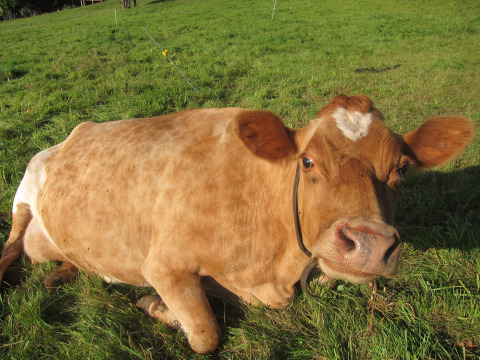
Here’s looking at you, E!
Amy just asked if I’d like to do a podcast about unschoo… er, immersion learning as a pathway to personal growth, and since I’d been lumpenly sitting here waiting for inspiration to strike (funny how I still think that can work, after something like two decades of repeatedly proving to myself that it doesn’t [and how ironic that I'm going to write about personal growth after admitting I've been doing the same unproductive shit for something like 20 years]), and since her request made me realize I’ve never addressed the subject in this space, at least not explicitly, I figured why the hell not. So buckle up: It’s personal growth, Ben-style.
I guess first I should say I’m not exactly sure how to define personal growth. I have this vague idea that it’s about becoming a more evolved version of one’s self. Maybe even a better version, though that seems awfully loaded. I mean, who’s defining “better”? And is it not a subjective measure, anyway? And should we even be striving to be better? Are we not damn well good enough as we are? Sigh. As seems my habit, more questions than answers.
So with the caveat that I’m not exactly sure how to define personal growth, at least not empirically and certainly not concisely, I’m nonetheless pretty sure I’ve experienced it. Furthermore, I’m pretty sure that a fair piece of this experience is rooted in our decision to follow the immersion learning path. I mean, of course it is, because I’m also pretty sure that you can’t go breeding and not experience some degree of personal growth (and if you can, it probably means you shouldn’t’ve gone and had kids in the first place). And in a way, immersion learning is parenthood amplified. It is parenthood without the buffer of school. In our home, it is also parenthood without the buffer of screen and so in our home, one can’t really differentiate between immersion learning and immersion parenting. One is the other and the other is one. Truthfully, I think that’s why some parents can’t even fathom such a thing as immersion learning: They don’t even want to spend that much time with their kids. Actually, I don’t think it; I know it, because I’ve been told as much, on more than one occasion.
I’m starting to realize this runs the risk of going on far too long, so I’ll cut to the chase and talk about one particularly striking aspect (striking to me, at least) of my so-called “personal growth” that I attribute in large part to our educational path: Confidence. Not just in my boys – though certainly, unquestionably that – but in myself.
There’s a million different ways this is true, but I suppose the most obvious is rooted in my observation that my children are more capable than I’d ever imagined children could be. I hope this doesn’t sound like bragging – I don’t mean to single out my children, because I think all children are more capable than we imagine them to be; we just don’t tend to give them opportunities to demonstrate how capable they are. But of course my children are the ones I know best, so they’re the obvious example.
When I say “capable,” I don’t mean merely from a skills perspective, though that’s part of it, to be sure. But more so, I mean from a perspective of resourcefulness, both physical and emotional. I think of Rye putting down his buckling, or hauling sap two gallons at a time from deep in the woods to boil over the little stone and brick arch he fashioned. I think of all Fin’s failures on his path toward making his first truly functional long bow. Over and over and over again he failed. And then, finally, he didn’t. When I say “capable,” I mean from the perspective of being hungry for experiences and willing to foment the knowledge these experiences require. Does that make sense?
Here’s how simple it is: Immersion learning and parenting has granted me a front row view of human resourcefulness and capability that I would not otherwise have known. And in that regard, it has meant that my children have become my teachers at least as much as I’ve been theirs. They have unwittingly made me more confident in my own capacity for resourcefulness and self-directed learning.
Because if my kids can do it, who’s to say I can’t?

September 23, 2014
Point Enough

Action shot
A couple years back, as I was milling around following a talk I’d done relating to my first book, an attractive woman approached and palmed me a note. This doesn’t happen too often, and by “too often,” I actually mean “ever.” I guess I’m just not the sort of fellow who inspires discreetly passed notes from attractive women. Or anyone else, come to think of it.
Anyway. There were exactly two words scrawled on that piece of paper: Read Ishmael. I’m pretty sure it wasn’t the first time I’d heard of Daniel Quinn’s novel, but it’s the first time I remember. Since then, I’m think Ishmael has been mentioned in the comments section of this space a time or two.
Still and all, it took me until the past few days to finally get around to it. For those of you who haven’t read it, Ishmael is the fictionalized account of one man’s mentorship at the hands of a gorilla named Ishmael. It sounds sort of ridiculous, but that’s part of the genius of the book, I think. The small absurdity of the arrangement – a man and a gorilla inaudibly communicating about the mythology of modern humankind – somehow makes it all the more accessible. If Quinn had simply presented his ideas in a non-fictionalized format, I suspect they wouldn’t have gained nearly as much traction.
There’s a lot to say about Ishmael, but the aspect that’s stuck with me is notion that humans have, by-and-large, transitioned from being a species of Leavers to a species of Takers. And furthermore, that much of what it means to be a Taker is written so indelibly into modern culture that we don’t even think to question its righteousness. This is part of the mythology Ishmael reveals.
There are many factors that go into differentiating between Leavers and Takers, but generally speaking, Takers aren’t content to merely compete for the minimum resources essential to their survival; they want to dominate. It’s not about having enough; it’s about having as much as possible. Or, at the very least, having more than can be reasonably justified by our perfectly logical quest for personal wellbeing.
All other species are, of course, Leavers, which is to say, they seem to innately understand the difference between, say, competing with rivals for the day’s nourishment and hoarding years, if not decades worth of resources, in the process making those resources inaccessible to others. And also potentially eradicating entire other species; witness the fact that the world is now losing species at 1,000 to 10,000 times the natural extinction rate, due primarily to human activity, most of which, when you get right down to it, is elective. And much of which, when you get right down to it, isn’t actually improving our wellbeing, either individually or collectively.
It’s not as if the ideas presented in Ishmael are so radical, at least to anyone who’d been living with the unsettling sense that perhaps things are not exactly as they’ve been taught (which I’m guessing is the majority of those who hang around here), but they are presented in a particularly clear and affecting manner.
As so often happens when you read something you knew but could not quite articulate, the book has prompted us to evaluate certain aspects of our life and in particular those aspects where the unquestioned assumptions of Taker culture are still rooted. Primarily I think of the sheer quantity of stuff we have accumulated over the years, most of it purchased used or even handed-down for free, to be sure, but still: Stuff. Enough to make our basement feel crowded. Enough that it often seems we spend more time rearranging it than actually using it. Enough that if you were to drop by right now and demand to see it all, I’d be sort of embarrassed. I mean, really: How did we end up with three circular saws? (Actually, I know exactly how, but it’s way too long a story to relay here)
I’m not sure what my point is. Perhaps in part it’s to acknowledge my own duplicity, all the ways in which I’ve lived – and continue to live – in accordance with the Taker story. But then, haven’t we all? Don’t we all? Maybe it’s just because I think you all ought read the book; it’s one of the few I’ve read, like Elliot Merrick’s True North, like Harry Middleton’s The Earth is Enough, like Charles Eisenstein’s Sacred Economics, that holds the promise of sticking with me long after I closed the cover, turned out the light, and asked Penny to please hold my grubby little hand until I fall asleep which, lucky for her, generally takes about 74 seconds.
I guess maybe that’s point enough.

September 22, 2014
Not Actually All That Wise
With the family away this weekend, I took to the stack of long-neglected sawlogs with a vengeance. I really like sawing lumber; there is something uniquely rewarding about pulling a fresh 2 x6 off the bed of the mill, the wood fibers damp and slightly furry-feeling, the sweet smell of fresh cut balsam mingling with the acrid exhaust of the sawmill motor. I’m guessing I sawed about 1500 board feet over the past couple of days, which is hardly anyone’s idea of a Herculean feat, I’ll admit. Then again, I was also milking two cows, tending to the sheep, pigs, and chickens, making butter and bread, weeding and mulching the bare earth from which the onions had recently been extracted, and feeding my lonely, sorry self, a task that consisted primarily of gnawing on hunks of half-cooked meat whilst leaning against the kitchen counter between chores, the same greasy fry pan serving as both cooking vessel and plate for all four days. Boys will be boys and all that.
One of my weekend tasks involved moving the pigs from where we’d been training them to electric fence into the wooded area that will be their home for the remaining three or four months of their earth-bound days. It just so happened that the most direct route from their training area to the woodlot routed them directly past the sawmill and through the large pile of saw dust that’s accrued on the backside of the mill. And so I had the distinctly rural pleasure of watching the pigs snuffle and snort in the sawdust even as the mill showered them with more dust with every pass of the toothy blade.
It was one of those experiences that somehow crystallizes the richness of this life in a way that defies logic and maybe even language: To transform logs into lumber while pigs romp joyously in the accumulated woody dander. I’d’ve thought they’d be scared of the mill’s snarl, but they seemed oblivious to the commotion and went about their important business as I went about mine. I suspect they were not nearly as comforted by my companionship as I was by theirs, but I allowed myself the luxury of pretending otherwise and this made me miss my family just a small bit less.
• • •
I’ve mentioned this briefly before, but I’m struggling a bit with how to accommodate the volume of inquiries and general correspondence pertaining to all the recent media exposure. I have tried to respond to most questions, but I have also missed some. In general, I find it much easier to respond to very specific questions (“what was the first knife you bought your sons?”) than more general questions (“how do I start unschooling my kids?”).
I guess I need to back up a bit. Basically, there are two ways I make my living. The first is by writing – I am, for lack of a better term, a working class writer, which is to say, writing is the primary means by which I support my family financially. Writing is not a lucrative business, at least not at my end of the spectrum, and the recent flurry of attention has done nothing to change that. This is not a lament, by the way. It’s just the truth.
The secondary means (though it many ways, it’s not secondary at all) of supporting my family is figuring out how to do for ourselves that which we would otherwise pay others to do for us. Hence growing the overwhelming majority of our food. Hence sawing our own lumber, which we’ll use to build our own structures. Hence helping Martha and Lynn put up their hay in exchange for cut rate pricing on our hay. Hence a hundred-and-one other things that enable us to live as we do.
Regarding all the recent inquiries, my central challenge is this: How do I respond to them all while still doing the work necessary to supporting our lives on this land? Because honestly, I just can’t afford to. If I said “yes” to all the requests for homestead tours alone, there’d be nothing worth touring because I’d spend all my time giving tours rather than actually doing the work that makes it into something people want to see in the first place.
If you look in the left-hand margin of this page, you’ll see that I’ve added a consulting page. Frankly, “consulting” feels a little formal to me, but I’m not sure what else to call it. Conversing? Gabbing? Shootin’ the shit? Whatever. I guess it’s all the same: An imperfect way to address the challenge outlined above.
The truth is, it’s really hard for me to think about charging to answer people’s questions, in part because I’m not at all certain I have the answers they’re seeking, and in part because I’d rather just do it for free. But I can no longer ignore the fact that I can’t afford to just do it for free. I can’t ignore the fact that we’ve spent the past two decades of our lives schooling ourselves in all the things you can’t learn in school (or in most schools, at least). In a sense, whatever experience and knowledge we’ve gleaned working this land is our stock in trade.
Here’s what I’m thinking: I would like to humbly offer these shit shootin’ services by donation. This seems the most honest way to me, though I realize it might put prospective clients (shit shootin’ partners?) in a tough spot. What if I don’t give enough and he’s offended? What if I give too much and appear a fool? What if his so-called advice is so damn worthless I feel compelled to charge him for my time? And so on.
So maybe it won’t work. Maybe I should settle on an hourly rate ($500 sounds about right to me). Maybe I should gussy up this site and write up some sort of resume with a bunch of big words that makes it sound like we know more than we actually do. No doubt conventional wisdom would suggest I not jokingly refer to prospective clients as “shit shootin’ partners.”
Then again, the older I get, the closer I come to accepting that while conventional wisdom might indeed be conventional, it is not actually all that wise.
By the way, please, please don’t let this dissuade you from sending emails or asking brief, specific questions. I’m offering this for folks who are looking for something more than a simple email exchange can provide.
Also, if any one has alternative ideas – or personal experience – on how to handle this, I’m all ears. Thank you!

Ben Hewitt's Blog
- Ben Hewitt's profile
- 37 followers




